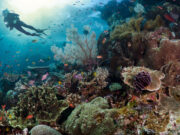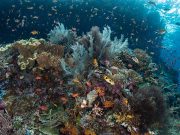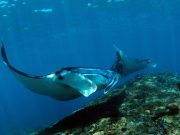Rising sea temperatures in the Mediterranean are encouraging alien lionfish species to invade. Cyprus has already been colonised.
Scientists are urging scuba divers and fishermen to remove the lionfish when they see them.
Lionfish have recently increased in abundance and within just one year have penetrated almost the entire south eastern coast of Cyprus.
At least 23 different lionfish were reported of which 6 were removed. Groups of the fish showing mating behaviour have been noted for the first time in the Mediterranean, according to a new report by Demetris Kletou, Jason M. Hall-Spencer and Periklis Kleitou published in Marine Biodiversity Records.
Given that the Suez Canal has recently been widened and deepened, the problem can only spread unless divers take action. There are now over 1000 alien species in the Mediterranean, but lionfish may be one of the most dangerous to native fish.
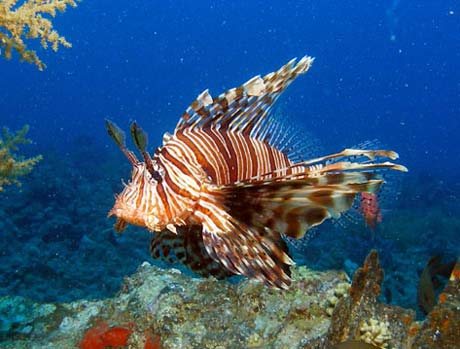
Photo by Tim Nicholson.
What is the problem with lionfish in the Mediterranean?
Voracious hunters, lionfish consume many different types of fish. They can live for 15 years. Lionfish spawn every four days, year-round, producing around two million buoyant gelatinous eggs per year. These ride the sea currents and can cover large distances for about a month before they settle, meaning lionfish can spread quickly. Their venomous spines deter predators so they can quickly colonise reefs.
When out of their own Red Sea environment they become a serious threat to the diversity of their foreign home. Research in the Bahamas showed that lionfish caused reductions of up to 80% in the recruitment of native fishes on experimental reefs. Other research shows that lionfish have reduced the abundance of small native reef fishes by up to 95% at some invaded sites.
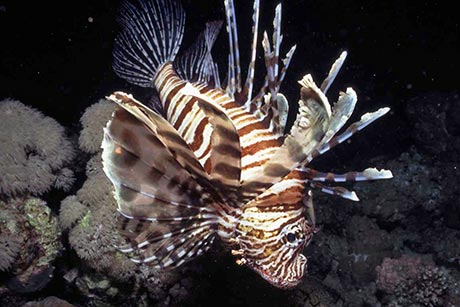
Photo by Tim Nicholson.
The lionfish invading the Mediterranean from the Red Sea are Pterois miles. These have spread rapidly in Cyprus from Limassol to Protaras in just a year. Divers and government officers that were questioned in the study told of more than ten additional lionfish sightings and captures, but as these were not photographed they were not included in the report.
Three pairs of lionfish have been photographed, one at the Zenobia wreck at 20 m depth, another near Cape Kiti at 42–43 m and one more at Cyclops caves near Cape Greco at 12–15 m depth. Lionfish are normally solitary, only pairing or gathering in groups to mate.
Research shows that culling can reduce lionfish abundance substantially, but removal rates must be high.
Lionfish have already very quickly colonised the east coast of the Americas, stretching from the Delaware Bay (Philadelphia) down to Brazilian waters and everywhere in between. It is thought these lionfish were introduced into Atlantic waters from private owners who found they could no longer look after their pets when they became too big.
Lionfish are not a problem in their native home – fish know to be wary of them and predators like sharks, cornetfish, grouper, large eels and other scorpionfish will eat them.
Further Reading
Lionfish, Pterois miles, Beautiful but Deadly
A lionfish (Pterois miles) invasion has begun in the Mediterranean Sea, Demetris Kletou, Jason M. Hall-Spencer and Periklis Kleitou
Marine Biodiversity Records 2016 9:46
Invasive Species of Florida’s Coastal Waters: The Red Lionfish (Pterois volitans) and Devil Firefish (P. miles), University of Florida.
Albins MA, Hixon MA (2008) Invasive Indo-Pacific lionfish Pterois volitans reduce recruitment of Atlantic coral-reef fishes. Mar Ecol Prog Ser 367:233-238
Côté et al., 2013
I.M. Côté, S.J. Green, M.A. Hixon. Predatory fish invaders: insights from Indo-Pacific lionfish in the western Atlantic and Caribbean
Biol. Conserv., 164 (2013), pp. 50–61






